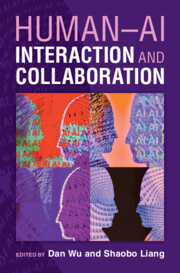
-
Select format
-
- Publisher:
- Cambridge University Press
- Publication date:
- September 2025
- October 2025
- ISBN:
- 9781009587877
- 9781009587853
- Dimensions:
- (229 x 152 mm)
- Weight & Pages:
- 0.59kg, 320 Pages
- Dimensions:
- Weight & Pages:
You may already have access via personal or institutional login
Book description
The integration of AI into information systems will affect the way users interface with these systems. This exploration of the interaction and collaboration between humans and AI reveals its potential and challenges, covering issues such as data privacy, credibility of results, misinformation, and search interactions. Later chapters delve into application domains such as healthcare and scientific discovery. In addition to providing new perspectives on and methods for developing AI technology and designing more humane and efficient artificial intelligence systems, the book also reveals the shortcomings of artificial intelligence technologies through case studies and puts forward corresponding countermeasures and suggestions. This book is ideal for researchers, students, and industry practitioners interested in enhancing human-centered AI systems and insights for future research.
Reviews
‘This book offers a comprehensive exploration of the dynamic interaction and collaboration between humans and AI across various domains. It tackles both the opportunities and challenges presented by AI, highlighting its potential to enhance productivity, ethical considerations, and its role in shaping the future of industries such as healthcare and education. A valuable resource for anyone interested in understanding the multifaceted impact of AI.’
Chuanfu Chen - Senior Professor of Humanities and Social Sciences, Wuhan University, China
Contents
Metrics
Altmetric attention score
Full text views
Full text views help Loading metrics...
Loading metrics...
* Views captured on Cambridge Core between #date#. This data will be updated every 24 hours.
Usage data cannot currently be displayed.
Accessibility standard: WCAG 2.2 AAA
Why this information is here
This section outlines the accessibility features of this content - including support for screen readers, full keyboard navigation and high-contrast display options. This may not be relevant for you.
Accessibility Information
The PDF of this book complies with version 2.2 of the Web Content Accessibility Guidelines (WCAG), offering more comprehensive accessibility measures for a broad range of users and attains the highest (AAA) level of WCAG compliance, optimising the user experience by meeting the most extensive accessibility guidelines.
Content Navigation
Table of contents navigation
Allows you to navigate directly to chapters, sections, or non‐text items through a linked table of contents, reducing the need for extensive scrolling.
Index navigation
Provides an interactive index, letting you go straight to where a term or subject appears in the text without manual searching.
Reading Order and Textual Equivalents
Single logical reading order
You will encounter all content (including footnotes, captions, etc.) in a clear, sequential flow, making it easier to follow with assistive tools like screen readers.
Short alternative textual descriptions
You get concise descriptions (for images, charts, or media clips), ensuring you do not miss crucial information when visual or audio elements are not accessible.
Full alternative textual descriptions
You get more than just short alt text: you have comprehensive text equivalents, transcripts, captions, or audio descriptions for substantial non‐text content, which is especially helpful for complex visuals or multimedia.
Visual Accessibility
Use of colour is not sole means of conveying information
You will still understand key ideas or prompts without relying solely on colour, which is especially helpful if you have colour vision deficiencies.
Use of high contrast between text and background colour
You benefit from high‐contrast text, which improves legibility if you have low vision or if you are reading in less‐than‐ideal lighting conditions.

